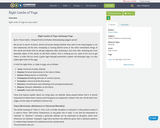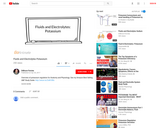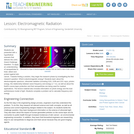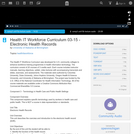
The Effects of Client Absenteeism and Lack of Engagement with Services on the Speech-Language Pathology Clinician
- Subject:
- Health, Medicine and Nursing
- Material Type:
- Reading
- Author:
- Courtney Miller
- Date Added:
- 07/01/2023

The Effects of Client Absenteeism and Lack of Engagement with Services on the Speech-Language Pathology Clinician

The Effects of In-Person Therapy vs. Teletherapy on Executive Development

The Effects of In-Person Therapy vs. Teletherapy on Executive Development

This resource is a video abstract of a research paper created by Research Square on behalf of its authors. It provides a synopsis that's easy to understand, and can be used to introduce the topics it covers to students, researchers, and the general public. The video's transcript is also provided in full, with a portion provided below for preview:
"A new study re-examining the validity of a major drug trial might have doctors rethinking how to treat heart attack survivors. Bolstered by the findings of a landmark clinical trial reported in 2015, the blood thinner ticagrelor has been increasingly prescribed by doctors to reduce the risk of heart attack in people with a history of heart problems. Now, researchers from France say those findings don’t apply to all patients who meet the original study’s criteria. That bias could prove critical for prescribers, who may witness more cases of serious bleeding and death among their patients than previously reported. The 2015 drug study, known as the PEGASUS trial, screened heart attack survivors from around the globe. Those selected for the trial had to be at least 65 years old, or at least 50 with diabetes. Results showed that, when combined with aspirin, ticagrelor significantly decreased the risk of stroke or a second heart attack. It did, however, increase the risk of major bleeding..."
The rest of the transcript, along with a link to the research itself, is available on the resource itself.

This resource is a video abstract of a research paper created by Research Square on behalf of its authors. It provides a synopsis that's easy to understand, and can be used to introduce the topics it covers to students, researchers, and the general public. The video's transcript is also provided in full, with a portion provided below for preview:
"Wet age-related macular degeneration, or wet AMD, occurs when newly formed blood vessels leak or bleed into the center of the retina, resulting in poor vision. Proactive treatment with intravitreal aflibercept has produced good outcomes in clinical studies. The treat-and-extend dosing strategy in particular has been shown to produce similar visual outcomes to fixed dosing every 4 or 8 weeks. And real-world evidence suggests that patients treated proactively in real life show outcomes similar to those observed in clinical trials. In the ALTAIR study, investigators explored how to fine-tune the proactive treat-and-extend approach in Japanese patients. The study aimed to identify the optimal extension interval for individual patients and individualize treatment with optimal extension to reduce the treatment burden for as many patients as possible. Ideally, treatments would be as infrequent as once every 16 weeks—with fast extensions made in 4-week increments—while maintaining initial vision gains..."
The rest of the transcript, along with a link to the research itself, is available on the resource itself.

This resource is a video abstract of a research paper created by Research Square on behalf of its authors. It provides a synopsis that's easy to understand, and can be used to introduce the topics it covers to students, researchers, and the general public. The video's transcript is also provided in full, with a portion provided below for preview:
"Worldwide, many patients treated for type 2 diabetes are not achieving their recommended glycemic targets. For patients with very poorly controlled diabetes, such as those with an HBA1C more than 2% above their target or with HbA1c over 10%, the ADA and EASD consensus recommendations include combination therapy with both basal insulin and a glucagon-like peptide-1 receptor agonist (or GLP-1 RA). iGlarLixi is a once-daily, titratable, fixed-ratio combination of basal insulin glargine 100 units (or glargine) and lixisenatide, a GLP-1 RA. The complementary mechanisms of action of lixisenatide and glargine means that this combination targets both fasting and post-prandial hyperglycemia with a single injection. To examine whether iGlarLixi is a therapeutic option for patients with very poorly controlled type 2 diabetes, the authors of the current study analyzed two sub-groups of the LixiLan-O clinical trial. Their findings are published in Diabetes, Obesity and Metabolism..."
The rest of the transcript, along with a link to the research itself, is available on the resource itself.

This resource is a video abstract of a research paper created by Research Square on behalf of its authors. It provides a synopsis that's easy to understand, and can be used to introduce the topics it covers to students, researchers, and the general public. The video's transcript is also provided in full, with a portion provided below for preview:
"Losing weight through lifestyle interventions alone can be challenging. Unfortunately, the options for effective drug treatment are limited. And those that are available require frequent, daily dosing. Now, a new treatment option tested among patients with diabetes could be a solution for those with obesity but not diabetes. Shown to significantly reduce body weight vs. placebo, efpeglenatide is one of the latest of an entire class of diabetes-targeted drugs observed to have beneficial effects beyond glycemic control. Efpeglenatide is a long-lasting glucagon-like peptide-1 receptor agonist, or GLP-1 RA. The drug is currently being developed to improve glycemic control in patients with type 2 diabetes as a once-weekly subcutaneous administration. But like other GLP-1 RAs, efpeglenatide also helps patients lose weight..."
The rest of the transcript, along with a link to the research itself, is available on the resource itself.

Introduction to the egg, sperm, and fertilization. Created in collaboration between the Association of American Medical Colleges and Khan Academy.

Eight Limbs of Yoga are very useful

This resource is a video abstract of a research paper created by Research Square on behalf of its authors. It provides a synopsis that's easy to understand, and can be used to introduce the topics it covers to students, researchers, and the general public. The video's transcript is also provided in full, with a portion provided below for preview:
"Even though Europe is far from malarial hot spots, doctors there still have to treat travelers who contract the disease while on holiday or business trips. And because Europeans aren’t exposed to malaria on a regular basis, if they do become infected with the parasites, they’re more likely to develop a severe case. To keep tabs on how malaria is treated across 12 European countries, the European Network for Tropical Medicine and Travel Health, or TropNet, regularly collects data. Now, a report on all of its severe malaria cases between 2006 and 2014 offers an unprecedented look at malaria treatment across the continent. Over the 8-year period, epidemiologists counted 185 cases of severe malaria in the network, primarily following visits to West or central Africa. The outcome was good for the vast majority of patients: 98.4 percent survived. But there was a lot of variation in how people were treated. Hospitals used 56 different drug combinations..."
The rest of the transcript, along with a link to the research itself, is available on the resource itself.

As part of the engineering design process to create testable model heart valves, students learn about the forces at play in the human body to open and close aortic valves. They learn about blood flow forces, elasticity, stress, strain, valve structure and tissue properties, and Young's modulus, including laminar and oscillatory flow, stress vs. strain relationship and how to calculate Young's modulus. They complete some practice problems that use the equations learned in the lesson mathematical functions that relate to the functioning of the human heart. With this understanding, students are ready for the associated activity, during which they research and test materials and incorporate the most suitable to design, build and test their own prototype model heart valves.

Short video on electrolyte balance with regard to potassium for anatomy and physiology.

Students are presented with a hypothetical scenario that delivers the unit's Grand Challenge Question: To apply an understanding of nanoparticles to treat, detect and protect against skin cancer. Towards finding a solution, they begin the research phase by investigating the first research question: What is electromagnetic energy? Students learn about the electromagnetic spectrum, ultraviolet radiation (including UVA, UVB and UVC rays), photon energy, the relationship between wave frequency and energy (c = λν), as well as about the Earth's ozone-layer protection and that nanoparticles are being used for medical applications. The lecture material also includes information on photo energy and the dual particle/wave model of light. Students complete a problem set to calculate frequency and energy.

This resource is a video abstract of a research paper created by Research Square on behalf of its authors. It provides a synopsis that's easy to understand, and can be used to introduce the topics it covers to students, researchers, and the general public. The video's transcript is also provided in full, with a portion provided below for preview:
"Residual paralysis is a significant problem in anesthesia. Despite advanced methods for quantifying patients’ recovery from neuromuscular blockade, devices that are both reliable and easy to use remain scarce. In a study recently published in the journal Anesthesiology, researchers compared neuromuscular monitors based on two different technologies to determine which might be better suited for quantifying recovery: acceleromyography or electromyography. Acceleromyography-based monitors measure recovery based on the force of muscle contraction, whereas devices that use electromyography, or EMG, measure muscle action potentials. Until recently, acceleromyography-based devices were the most frequently used type of neuromuscular monitor. Obtaining reliable measurements with these devices, however, often requires clinicians to take several precautions, such as fixing the arm in the supine position, calibrating the device, or normalizing the results..."
The rest of the transcript, along with a link to the research itself, is available on the resource itself.

This unit describes the overview and introduction to the electronic health record (EHR).

In this task from ClimeTime educators, students will demonstrate understanding of natural resources and their uses with respect to their impact on the Earth. Students will do short explanations, drawing an image, and providing evidence to support an argument.
Resource includes a student task document, teacher guide, and task facilitation slides.

This Unit is a collection resources that cover a 4 week span. This unit was designed with EL students in mind. Each day has vocabulary that will allow students learn key phrases and attributes of each career. Each week a different categories of careers is highlighted through books, activites, and videos. The categories include:Week 1: Farming CareersWeek 2: Health CareersWeek 3: Environmental CareersWeek 4: Art Careers Projected Funded by: PGE Foundation #PoweringPotentialProject Coordinated by: South Metro-Salem STEM Partnership

This lesson was created for use in the elemenatry PE classroom. It can be adapted for all age groups and ability levels. It allows flexibility for skills of all students. The only materials needed are hula hopps and there can be many variations added to make the game more complicated or can be simplified if necessary.

Presentación orientada a adolescentes, para dar recomendaciones sobre medidas previas al embarazo adolescente. Consecuencias físicas y psicológicas, además del correcto uso de los métodos anticonceptivos.

This resource is a video abstract of a research paper created by Research Square on behalf of its authors. It provides a synopsis that's easy to understand, and can be used to introduce the topics it covers to students, researchers, and the general public. The video's transcript is also provided in full, with a portion provided below for preview:
"Over the past few decades, the pharmaceutical industry has shifted its focus to areas of high unmet need Such as treating cancer and rare diseases For many of these conditions, traditional approaches to clinical trial design fall short The transition therefore calls for innovative clinical and regulatory strategies that can deliver new drugs fast Advanced digital technologies now offer unprecedented opportunities to improve drug development and, by extension, patients’ lives These include capturing patient-reported outcomes facilitating accelerated regulatory approval pathways analyzing real-world data and using intelligent analytics solutions While the tools and practices for unlocking the potential of innovation abound pharma is only in the early stages of adapting them at scale Aligning the needs of patients, providers, payers, and regulators will require biopharma organizations to adapt and evolve And leveraging digital tools, data, and analytics could help them get there Lee e.."
The rest of the transcript, along with a link to the research itself, is available on the resource itself.